A Numerical Approach to Optimize the Design of a Pintle Injector for LOX/GCH4 Liquid-Propellant Rocket Engine
Abstract
1. Introduction
2. Theoretical Background
2.1. Pintle Injector
2.1.1. Concept of a Pintle Injector
2.1.2. Flows of Propellant
2.1.3. Pintle Injector Dimensions
2.1.4. Pintle Injector Performance
2.2. Performance and Design Variables
2.2.1. Atomization
2.2.2. Mixing
2.2.3. Vaporization Distance
2.3. Impact Evaluation
3. Optimal Pintle Injector Design
3.1. Design Point
3.2. Optimization Theory
3.3. Constraints of Design Variables
- should be in the range between 5 mm and 100 mm because a smaller pintle tip is hard to manufacture, and a larger tip is excessively large in this study.
- should be in the range between 0.01 mm and 6 mm since a smaller annular gap thickness is hard to manufacture, and a larger gap is excessively large in this study.
- should be larger than 0.1 mm since Ref. [19] found that an opening distance lower than the limit can cause formation trouble of a uniform liquid sheet outside the pintle tip.
- should be in the range between 0.05 and 0.3. This ratio is generally set at around 20% based on a rule of thumb. A higher value means more expensive pressure machinery and a lower value causes negative effects, such as chugging. Ref. [40] demonstrates engines with a 5% pressure ratio, so we determine the ratio as the lower limit.
- The velocity of propellant injection should be slower than the sonic velocity. It is not desirable because the supersonic injector rockets are less efficient than the sonic injectors and produce less thrust per unit mass flow [41], and the combustion chamber can be highly harmful when a supersonic flow is present because it cause high pressure and shock wave [42,43,44].
3.4. Analyze the Weight Factor Impact
4. Verification and Discussions
5. Conclusions
Author Contributions
Funding
Institutional Review Board Statement
Informed Consent Statement
Data Availability Statement
Acknowledgments
Conflicts of Interest
References
- Gilroy, R.; Sackheim, R. The Lunar module descent engine-a historical summary. In Proceedings of the 25th Joint Propulsion Conference, Monterey, CA, USA, 10–12 July 1989; p. 2385. [Google Scholar]
- Betts, E.; Frederick, R. A historical systems study of liquid rocket engine throttling capabilities. In Proceedings of the 46th AIAA/ASME/SAE/ASEE Joint Propulsion Conference & Exhibit, Nashville, TN, USA, 25–28 July 2010; p. 6541. [Google Scholar]
- Casiano, M.J.; Hulka, J.R.; Yang, V. Liquid-propellant rocket engine throttling: A comprehensive review. J. Propuls. Power 2010, 26, 897–923. [Google Scholar] [CrossRef]
- Choo, K.; Mun, H.; Nam, S.; Cha, J.; Ko, S. A survey on recovery technology for reusable space launch vehicle. J. Korean Soc. Propuls. Eng. 2018, 22, 138–151. [Google Scholar] [CrossRef]
- Muelhaupt, T.J.; Sorge, M.E.; Morin, J.; Wilson, R.S. Space traffic management in the new space era. J. Space Saf. Eng. 2019, 6, 80–87. [Google Scholar] [CrossRef]
- Kuntanapreeda, S.; Hess, D. Opening access to space by maximizing utilization of 3D printing in launch vehicle design and production. Appl. Sci. Eng. Prog. 2021, 14, 143–145. [Google Scholar] [CrossRef]
- Yao, Z.; Qi, Y.; Bao, W.; Zhang, T. Thrust Control Method and Technology of Variable-Thrust Liquid Engine for Reusable Launch Rocket. Aerospace 2022, 10, 32. [Google Scholar] [CrossRef]
- Austin, B.L.; Heister, S.; Anderson, W. Characterization of pintle engine performance for nontoxic hypergolic bipropellants. J. Propuls. Power 2005, 21, 627–635. [Google Scholar] [CrossRef]
- Bedard, M.; Feldman, T.; Rettenmaier, A.; Anderson, W. Student design/build/test of a throttleable LOX-LCH4 thrust chamber. In Proceedings of the 48th AIAA/ASME/SAE/ASEE Joint Propulsion Conference & Exhibit, Atlanta, GA, USA, 30 July 2012–1 August 2012; p. 3883. [Google Scholar]
- Fang, X.-x.; Shen, C.-b. Study on atomization and combustion characteristics of LOX/methane pintle injectors. Acta Astronaut. 2017, 136, 369–379. [Google Scholar] [CrossRef]
- Son, M.; Radhakrishnan, K.; Yoon, Y.; Koo, J. Numerical study on the combustion characteristics of a fuel-centered pintle injector for methane rocket engines. Acta Astronaut. 2017, 135, 139–149. [Google Scholar] [CrossRef]
- Radhakrishnan, K.; Son, M.; Lee, K.; Koo, J. Effect of injection conditions on mixing performance of pintle injector for liquid rocket engines. Acta Astronaut. 2018, 150, 105–116. [Google Scholar] [CrossRef]
- Dai, J.; Yu, H. Numerical and experimental investigations of geometrical parameters on GH2/GO2 injector. Aerosp. Sci. Technol. 2020, 106, 106187. [Google Scholar] [CrossRef]
- Son, M.; Lee, K.; Koo, J. Characteristics of anchoring locations and angles for GOX/GCH4 flames of an annular pintle injector. Acta Astronaut. 2020, 177, 707–713. [Google Scholar] [CrossRef]
- Zhang, Y.; Yu, N.; Tian, H.; Li, W.; Feng, H. Experimental and numerical investigations on flow field characteristics of pintle injector. Aerosp. Sci. Technol. 2020, 103, 105924. [Google Scholar] [CrossRef]
- Zhao, F.; Zhang, H.; Zhang, H.; Bai, B.; Zhao, L. Review of atomization and mixing characteristics of pintle injectors. Acta Astronaut. 2022, 200, 400–419. [Google Scholar] [CrossRef]
- Zhou, R.; Shen, C. Experimental study on the spray characteristics of a pintle injector element. Acta Astronaut. 2022, 194, 255–262. [Google Scholar] [CrossRef]
- Jin, X.; Yang, Y.; Cao, X.; Wu, J. Effect of Local Momentum Ratio on Spray Windward Distribution of a Gas–Liquid Pintle Injector Element. Aerospace 2022, 9, 494. [Google Scholar] [CrossRef]
- Son, M.; Radhakrishnan, K.; Koo, J.; Kwon, O.C.; Kim, H.D. Design Procedure of a movable pintle injector for liquid rocket engines. J. Propuls. Power 2017, 33, 858–869. [Google Scholar] [CrossRef]
- Erkal, B.; Sumer, B.; Aksel, M.H. Design and Cold Flow Experiment Procedure of a Pintle Injector. In Proceedings of the AIAA Propulsion and Energy 2019 Forum, Indianapolis, IN, USA, 19–22 August 2019; p. 4117. [Google Scholar]
- Rajendran, R.; Prasad, S.; Subhashree, S.; Phutane, T.S.; Saoor, V.S. Design and optimization of pintle injector for liquid rocket engine. Int. J. Eng. Appl. Sci. Technol. 2020, 5, 151–159. [Google Scholar] [CrossRef]
- Sutton, G.P.; Biblarz, O. Rocket Propulsion Elements; John Wiley & Sons: Hoboken, NJ, USA, 2016. [Google Scholar]
- Son, M. Correlations between Spray and Combustion Characteristics of a Movable Pintle Injector for Liquid Rocket Engines. Ph.D. Thesis, Department of Aerospace and Mechanical Engineering, Korea Aerospace University, Goyang, Republic of Korea, 2017. [Google Scholar]
- Hill, P.G.; Peterson, C.R. Mechanics and Thermodynamics of Propulsion; Addison-Wesley: Boston, MA, USA, 1992. [Google Scholar]
- Vasques, B.B.; Haidn, O.J. Effect of pintle injector element geometry on combustion in a liquid oxygen/liquid methane rocket engine. In Proceedings of the 7th European Conference for Aeronautics and Space Sciences (EUCASS), Milan, Italy, 3–6 July 2017; p. 88. [Google Scholar]
- Kowalczuk, P.B.; Drzymala, J. Physical meaning of the Sauter mean diameter of spherical particulate matter. Part. Sci. Technol. 2016, 34, 645–647. [Google Scholar] [CrossRef]
- Dressler, G.; Bauer, J. TRW pintle engine heritage and performance characteristics. In Proceedings of the 36th AiAA/ASME/SAE/ASEE Joint Propulsion Conference and Exhibit, Las Vegas, NV, USA, 24–28 July 2000; p. 3871. [Google Scholar]
- Quan, S.; Schmidt, D.P. Direct numerical study of a liquid droplet impulsively accelerated by gaseous flow. Phys. Fluids 2006, 18, 102103. [Google Scholar] [CrossRef]
- Gordon, S.; McBride, B.J. Computer Program for Calculation of Complex Chemical Equilibrium Compositions and Applications. Part 1: Analysis; Technical Report; NASA Lewis Research Center: Cleveland, OH, USA, 1994. [Google Scholar]
- Martins, J.R.; Ning, A. Engineering Design Optimization; Cambridge University Press: Cambridge, UK, 2021. [Google Scholar]
- Cai, G.; Fang, J.; Xu, X.; Liu, M. Performance prediction and optimization for liquid rocket engine nozzle. Aerosp. Sci. Technol. 2007, 11, 155–162. [Google Scholar] [CrossRef]
- Yelchuru, R.; Skogestad, S. Convex formulations for optimal selection of controlled variables and measurements using mixed integer quadratic programming. J. Process. Control 2012, 22, 995–1007. [Google Scholar] [CrossRef]
- Bartlett, R.A.; Biegler, L.T.; Backstrom, J.; Gopal, V. Quadratic programming algorithms for large-scale model predictive control. J. Process. Control 2002, 12, 775–795. [Google Scholar] [CrossRef]
- Corke, P.I.; Khatib, O. Robotics, Vision and Control: Fundamental Algorithms in MATLAB; Springer: Berlin/Heidelberg, Germany, 2011; Volume 73. [Google Scholar]
- Zhang, Z.; Li, J.; Wang, J. Sequential convex programming for nonlinear optimal control problems in UAV path planning. Aerosp. Sci. Technol. 2018, 76, 280–290. [Google Scholar] [CrossRef]
- Jo, B.U.; Ahn, J. Near time-optimal feedback instantaneous impact point (IIP) guidance law for rocket. Aerosp. Sci. Technol. 2018, 76, 523–529. [Google Scholar] [CrossRef]
- Jouini, T.; Rantzer, A. On cost design in applications of optimal control. IEEE Control Syst. Lett. 2021, 6, 452–457. [Google Scholar] [CrossRef]
- Cha, J.; de Oliveira, É.J. Robust Guidance and Control of Liquid-Propellant Rocket Engines for Landing of Reusable Stages using Fuzzy PID Control. In Proceedings of the 72th International Astronautical Congress (IAC), Dubai, United Arab Emirates, 25–29 October 2021. [Google Scholar]
- Mercieca, E. Spray Characteristics in Gas/Liquid Pintle Injection. Master’s Thesis, Department of Aerospace Engineering, Delft University of Technology, Delft, The Netherlands, 2017. [Google Scholar]
- Huzel, D.K.; Huang, D.H. Modern Engineering for Design of Liquid-Propellant Rocket Engines; AIAA: San Diego, CA, USA, 1992; Volume 147. [Google Scholar]
- Nelson, K.; Hawk, C. Experimental Investigation of an Integrated Strut-Rocket/Scramjet Operating at Mach 4.0 and 6.5 Conditions; Jannaf Propulsion Meeting: Cleveland, OH, USA, 1998. [Google Scholar]
- Pennington, D.; Man, T.; Persons, B. Rocket Propulsion Hazard Summary: Safety Classification, Handling Experience and Application to Space Shuttle Payload; Technical Report; NASA: Washington, DC, USA, 1977. [Google Scholar]
- Osipov, V.; Muratov, C.; Hafiychuk, H.; Ponizovskaya-Devine, E.; Smelyanskiy, V.; Mathias, D.; Lawrence, S.; Werkheiser, M. Hazards Induced by Breach of Liquid Rocket Fuel Tanks: Conditions and Risks of Cryogenic Liquid Hydrogen-Oxygen Mixture Explosions. arXiv 2010, arXiv:1012.5135. [Google Scholar]
- Chen, Y.; Liu, X.; Wang, J. Effects of Reversed Shock Waves on Operation Mode in H2/O2 Rotating Detonation Chambers. Energies 2021, 14, 8296. [Google Scholar] [CrossRef]
- Multiphysics, C. Introduction to COMSOL Multiphysics; COMSOL Multiphysics: Burlington, MA, USA, 2016. [Google Scholar]
- Andersson, E. Numerical Approach to the Design and Optimisation of a Bi-Propellant Pintle Injector. Master’s Thesis, Department of Computer Science, Electrical and Space Engineering, Space Technology, Luleå University of Technology, Kiruna, Sweden, 2022. [Google Scholar]
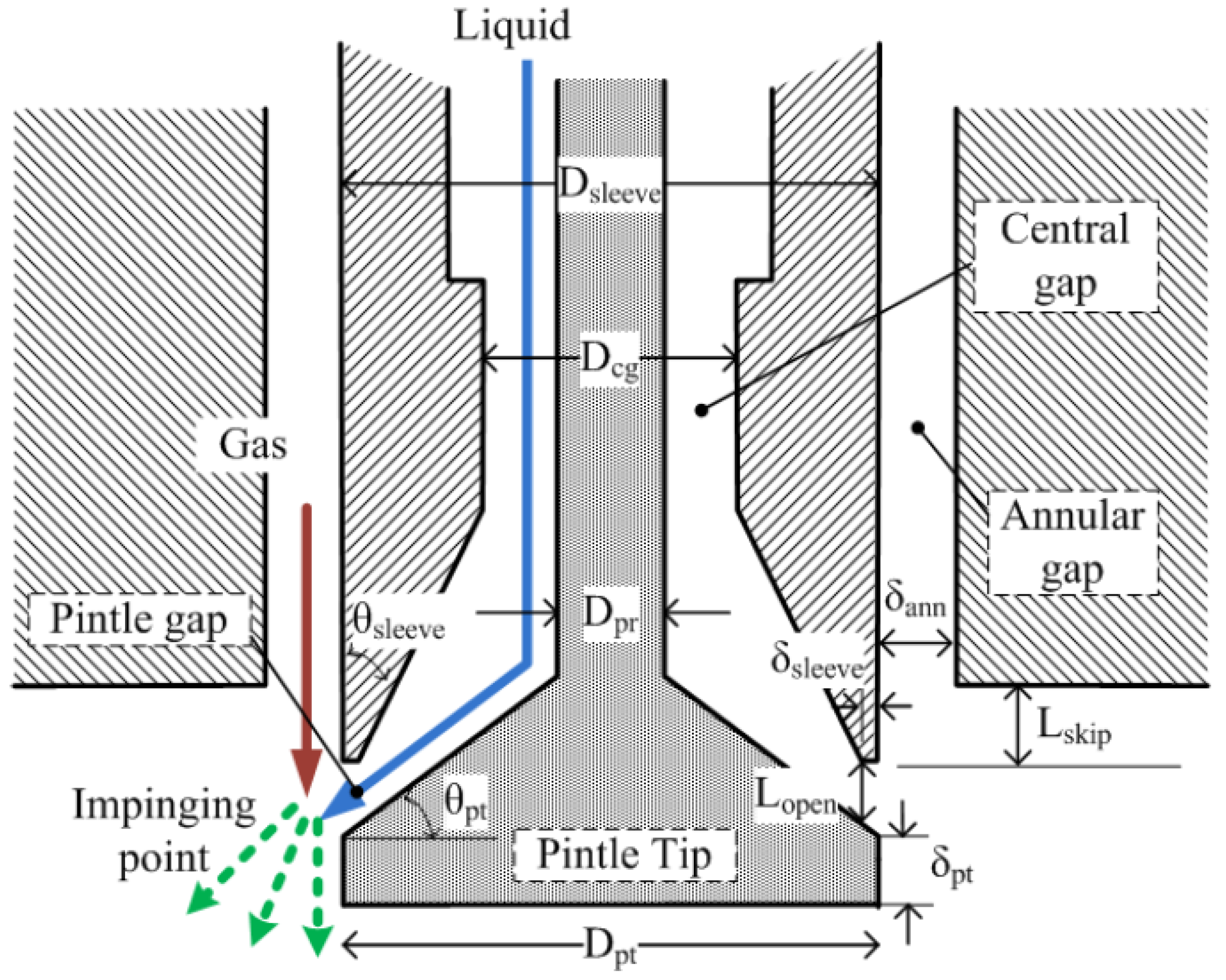
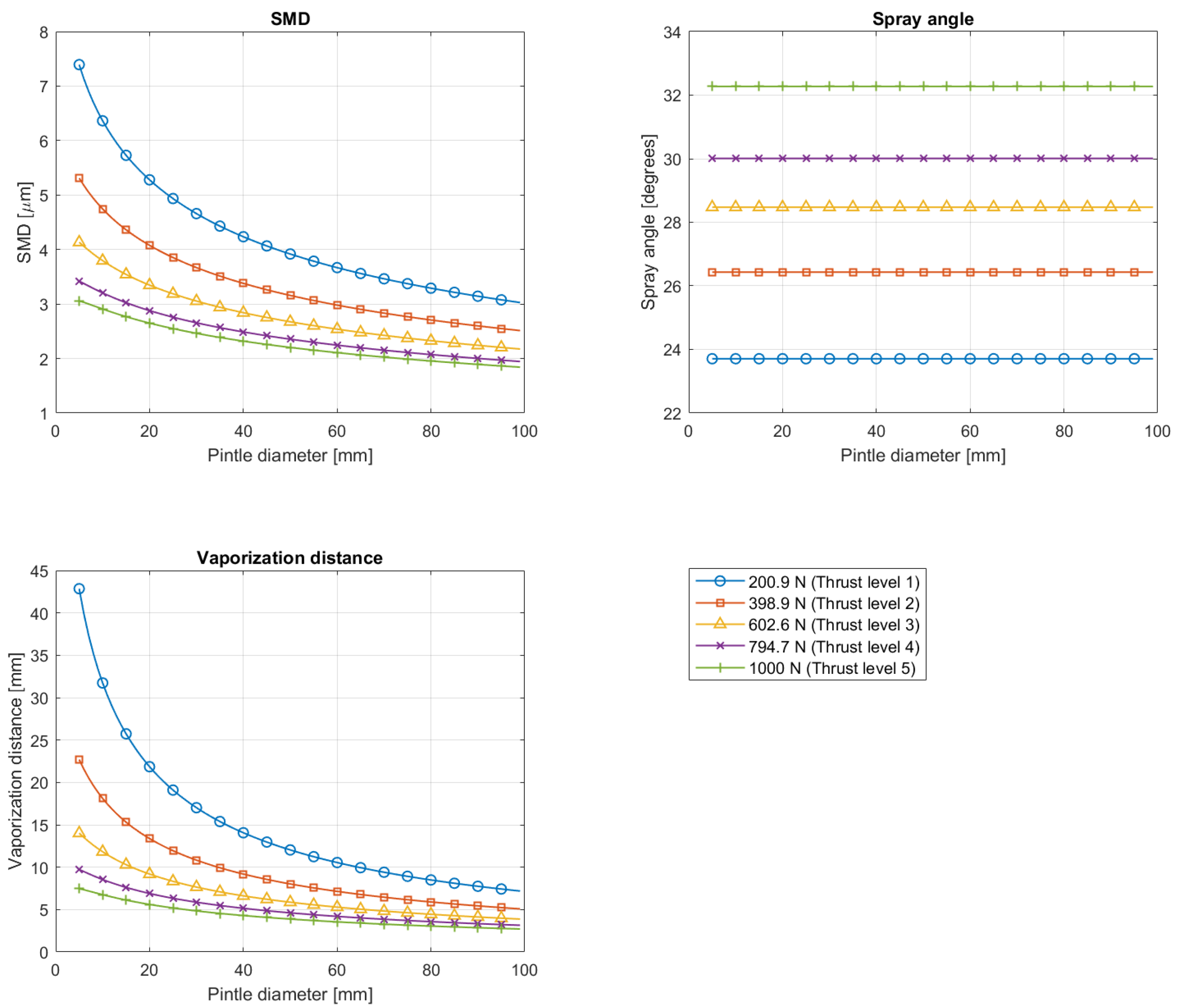
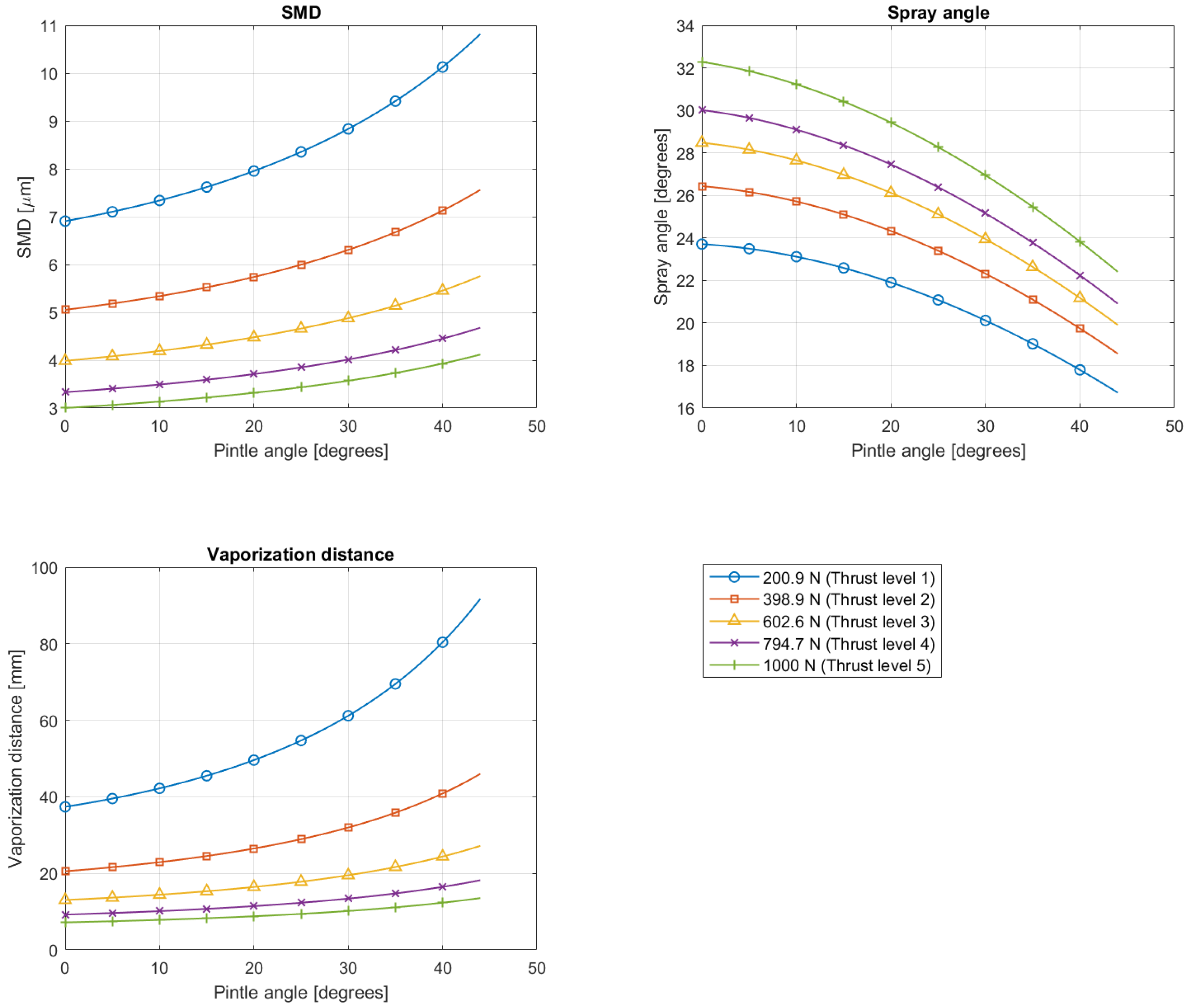
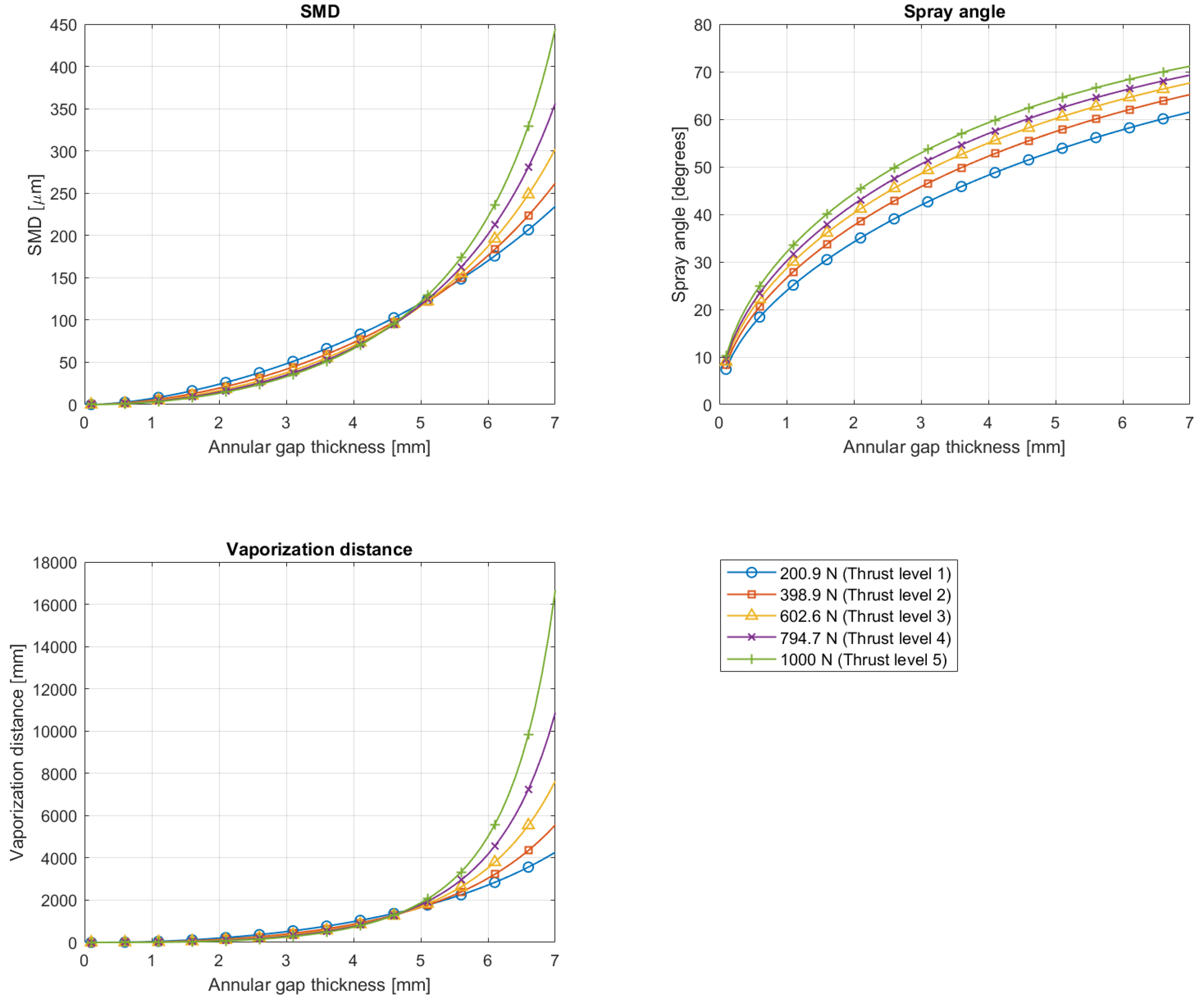
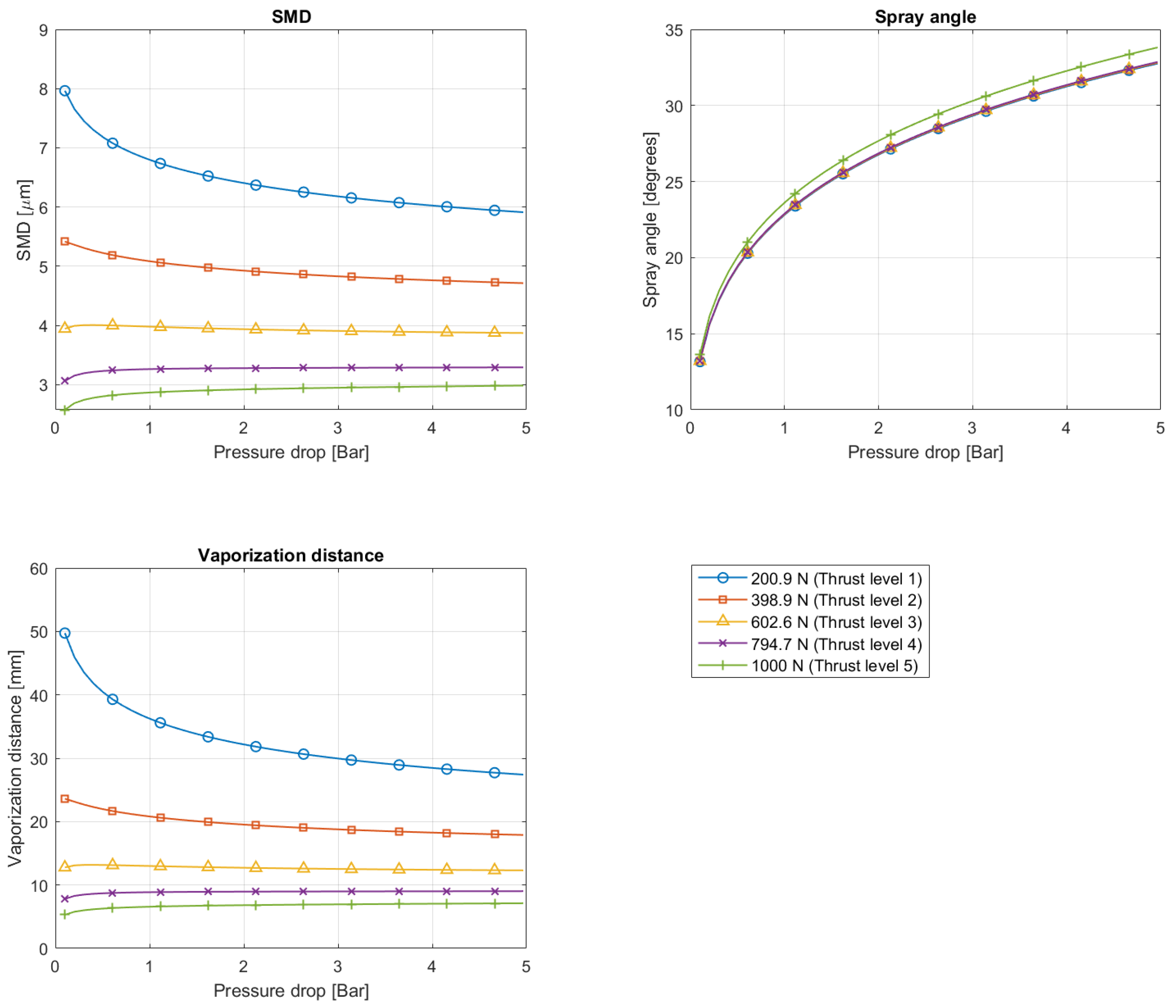
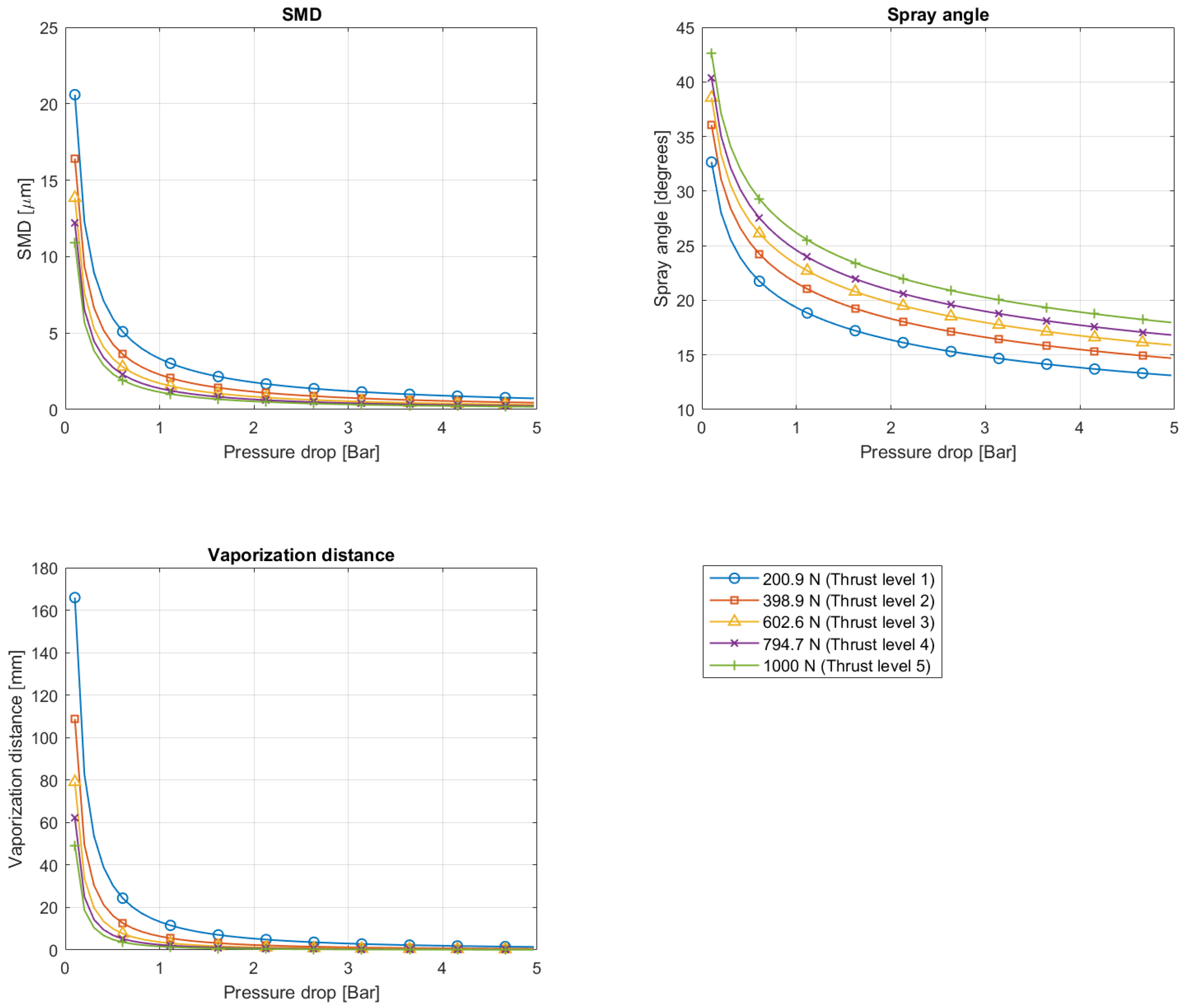
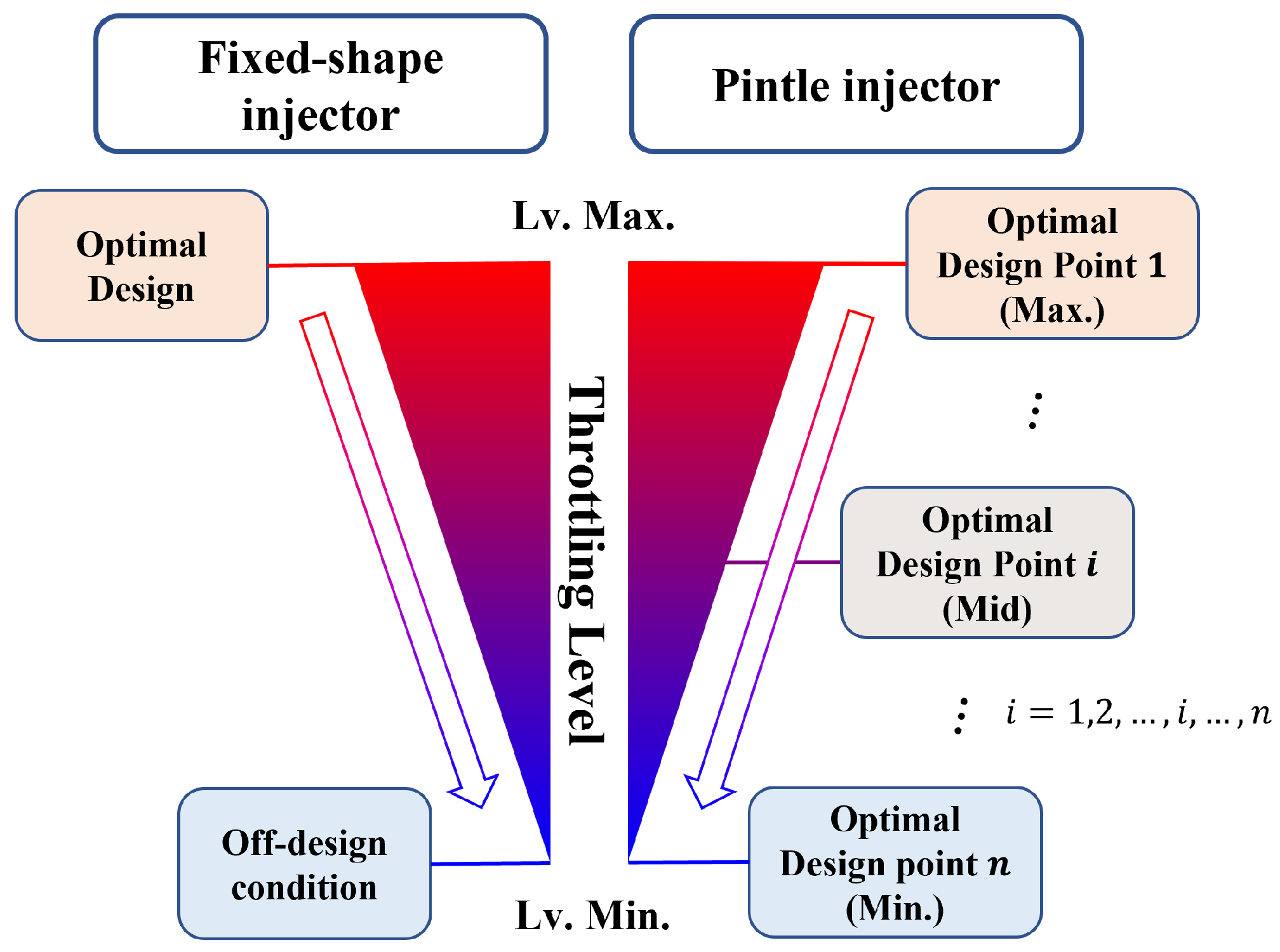




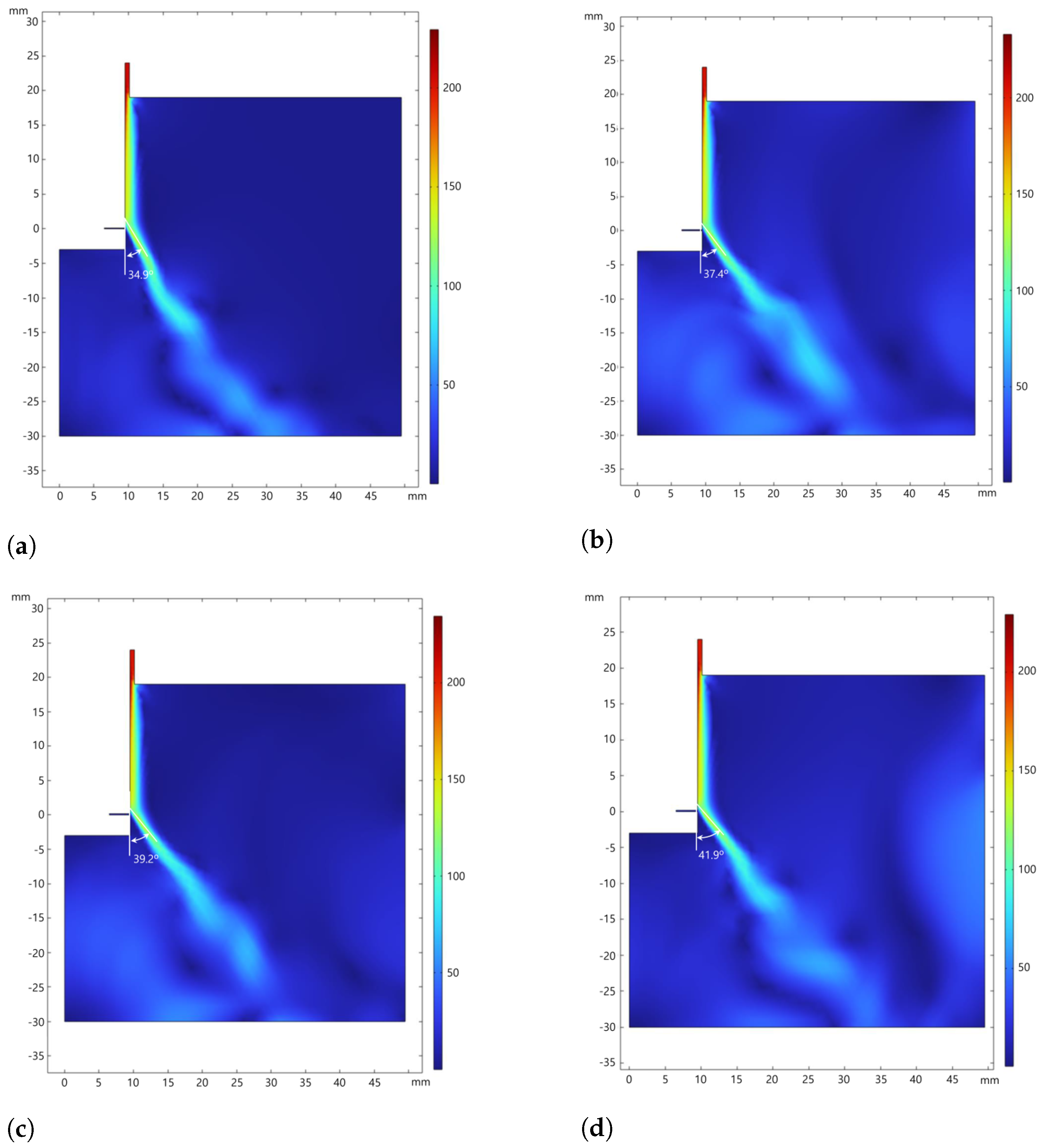
| Thrust Level | Desired Thrust [N] | Characteristic Velocity [m/s] | Desired O/F Ratio |
|---|---|---|---|
| 1 | 200 | 1854.4 | 2.6 |
| 2 | 400 | 1861.1 | 2.6 |
| 3 | 600 | 1865.4 | 2.6 |
| 4 | 800 | 1868.3 | 2.6 |
| 5 | 1000 | 1871 | 2.7 |
| Thrust Level | Calculated Thrust [N] | Chamber Pressure [bar] | Oxidizer Mass Flow [kg/s] | Fuel Mass Flow [kg/s] |
|---|---|---|---|---|
| 1 | 200.9 | 5.9 (29.5% of max ) | 0.0811 | 0.0312 |
| 2 | 398.9 | 9.4 (47% of max ) | 0.1288 | 0.0495 |
| 3 | 602.6 | 13 (65% of max ) | 0.1777 | 0.0683 |
| 4 | 794.7 | 16.4 (82% of max ) | 0.2238 | 0.0861 |
| 5 | 1000 | 20 (max ) | 0.2754 | 0.1020 |
| SMD | + | - | - | +/- | + |
| X | + | - | - | +/- | + |
| - | + | + | - |
| Thrust Level | [mm] | [degrees] | [mm] | [bar] | [bar] | [mm] |
|---|---|---|---|---|---|---|
| 1 | 19 | 0 | 0.70 | 1.77 | 1.0429 | 0.1020 |
| 2 | - | - | - | 2.82 | 1.6496 | 0.1283 |
| 3 | - | - | - | 3.90 | 2.2709 | 0.1505 |
| 4 | - | - | - | 4.92 | 2.8559 | 0.1688 |
| 5 | - | - | - | 6.00 | 3.2876 | 0.1880 |
| Thrust Level | SMD [μm] | [degrees] | X [mm] |
|---|---|---|---|
| 1 | 9.4749 | 31.5106 | 4.6320 |
| 2 | 7.7679 | 34.8878 | 3.1984 |
| 3 | 6.6811 | 37.3687 | 2.4133 |
| 4 | 5.9621 | 39.2061 | 1.9503 |
| 5 | 5.6664 | 41.8715 | 1.6914 |
Disclaimer/Publisher’s Note: The statements, opinions and data contained in all publications are solely those of the individual author(s) and contributor(s) and not of MDPI and/or the editor(s). MDPI and/or the editor(s) disclaim responsibility for any injury to people or property resulting from any ideas, methods, instructions or products referred to in the content. |
© 2023 by the authors. Licensee MDPI, Basel, Switzerland. This article is an open access article distributed under the terms and conditions of the Creative Commons Attribution (CC BY) license (https://creativecommons.org/licenses/by/4.0/).
Share and Cite
Cha, J.; Andersson, E.; Bohlin, A. A Numerical Approach to Optimize the Design of a Pintle Injector for LOX/GCH4 Liquid-Propellant Rocket Engine. Aerospace 2023, 10, 582. https://doi.org/10.3390/aerospace10070582
Cha J, Andersson E, Bohlin A. A Numerical Approach to Optimize the Design of a Pintle Injector for LOX/GCH4 Liquid-Propellant Rocket Engine. Aerospace. 2023; 10(7):582. https://doi.org/10.3390/aerospace10070582
Chicago/Turabian StyleCha, Jihyoung, Erik Andersson, and Alexis Bohlin. 2023. "A Numerical Approach to Optimize the Design of a Pintle Injector for LOX/GCH4 Liquid-Propellant Rocket Engine" Aerospace 10, no. 7: 582. https://doi.org/10.3390/aerospace10070582
APA StyleCha, J., Andersson, E., & Bohlin, A. (2023). A Numerical Approach to Optimize the Design of a Pintle Injector for LOX/GCH4 Liquid-Propellant Rocket Engine. Aerospace, 10(7), 582. https://doi.org/10.3390/aerospace10070582





